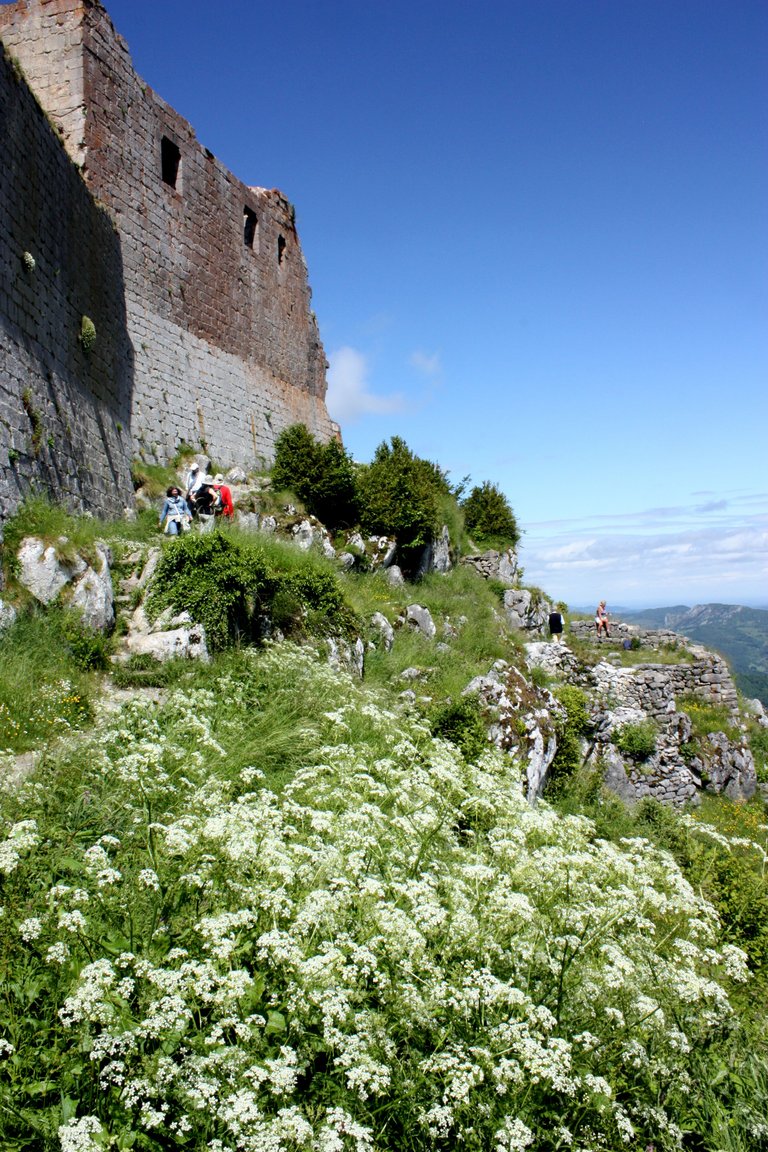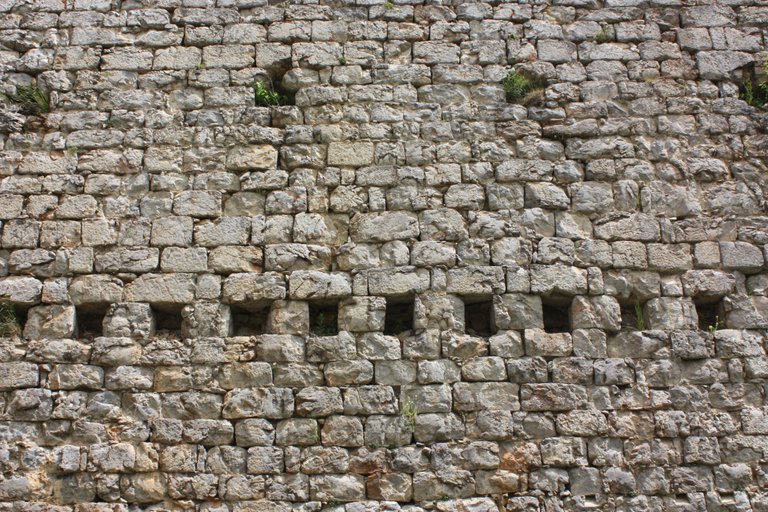I visited Montsegur to see the place where the Cathars had made their ‘last stand’ against the besieging forces of the King of France. I was also intrigued about the Cathar treasure many people believe was spirited away during the final days of the siege.
This was the view of the castle from the village of Montsegur
By the beginning of 1240 most Cathar leaders, and almost certainly the Cathar treasure, had taken refuge at Montsegur as the soldiers of the Albigensian Crusade had destroyed many of the other 20 castles in the region. The excuse to attack Montsegur was the assassination of two Inquisitors at Avignonet, which according to the crusaders, was undertaken by troops from Montsegur. The decision to attack Montsegur was taken at the Council of Beziers in April 1243. The siege started one month later and lasted for ten months. The defenders were hoping to hold the castle throughout the long summer and to collect water in the winter as they were convinced the attackers would lift the siege during these long cold months in the mountains. The Cathars were able to maintain communications with the outside world during the siege thanks to a number of hidden paths on the hill where Montsegur stood.
However, the Crusaders went on fighting during the winter and eventually were able to climb one of the cliffs allowing them to bombard the castle with rocks from close range. From this moment the defenders were doomed. A counter attack at the end of February met with no success. The soldiers and the Cathars in Montsegur agreed to ask for negotiations and good conditions for the soldiers were guaranteed after a strong intervention from the count of Toulouse. The castle was then left to the Cathars for a period of 15 days and no one has ever been able to explain why. On March 16th, the soldiers and their families were allowed to leave after confession. The Parfaits had the choice between adjuring their religion or being burned at the stake. All the Cathars chose to die as well as some soldiers and members of their families who first received the Consolamentum.
On March 16th, 1244, beneath the looming edifice of Montsegur, approximately 200 people marched out in file onto a great meadow where they were fenced in. Dry tinder and branches were piled around them and they were all burnt in an enormous pyre. This place is now known as the prat del cremats ("field of the burned"). Of course these were the Cathars who had chosen not to flee the castle by other means in the days before the surrender. Other Cathars had a most important task. Legend has it that during the 15 days of grace many Parfaits were lowered from the castle over a cliff although quite how they all evaded the besiegers of the castle is never satisfactorily explained. These Cathars took the treasure with them. It is not known if this treasure was actual gold and silver or of a more spiritual nature such as writing and other Catharist documents. A story says that this treasure was hidden in caves near Tarascon which neatly fits with the story of Otto Skorzeny’s discovery described in the previous blog about Rennes-le-Chateau
The history of the Cathars seem to indicate they were a branch of the Bogomil sect of Christianity, who inherited the Manichaean heresy when it came to Bulgaria. From Bulgaria the Bogomils spread their religion to some parts of Italy, Northern Spain and Southern France, where they were called Cathars (Pure Ones) or the Bons Hommes (the Kind or Good People). Their lifestyle contrasted with the immorality of the Roman Catholic clergy.
The Cathars had bishops and deacons as did the earlier Alexandrian Gnostics and the early Christian Church as a whole. They held a distinction between the initiated Knowers (Perfecti) and the uninitiated and faithful Believers (Credenti). They celebrated a communal meal in a sacramental fashion, recited the Lord’s Prayer as a sacrament and were particularly known for their practice of the sacramental rite of the Consolamentum. They combined both nobility and peasantry and treated each other from whatever social class as brother or sister. They opposed the Catholic sacraments in response to the increasing materialism of the Roman Catholic Church.
Because of their popularity, the Cathars eventually became a threat to the power and authority of the established Church. Catholic churches grew more and more empty as people flocked to this spiritually living movement preaching a doctrine of simplicity and a higher love. The Vatican began to worry and decided that this heresy could not be tolerated. The main enemy was Raymond VI, Count of Toulouse, brother in law of the King of England and cousin of the King of France. Pope Innocent III asked him to keep his vassals in line and to resolve the heretic problem. Raymond listened and didn’t do anything, so Innocent III appointed Peter of Castelnau in 1203 as his Legate in Languedoc.
Peter’s orders were to purge the Languedoc of the heresy. He organised a league against the Cathars and excommunicated Raymond VI for refusing to join it. In 1208 a knight killed the Legate as he crossed the Rhone. Raymond VI was thought to be responsible and a crusade was organised for the first time against a group inside Europe or Christendom. The Albigensian crusade against the Cathars, however, was political rather than religious. King Phillippe Auguste of France wanted the rich lands and wealth of Southern France, so he joined with the Pope to declare a religious crusade against them. This crusade culminated with the burning of the survivors of the siege of Montsegur. The fall of Montsegur was the end of organised Catharism in Languedoc. The movement went on in isolated villages and in the minds of some people, but had lost its strength and threat to the Roman Catholic Church.
One of the best things about a visit to Montsegur is that the castle is not very accessible to hordes of people as the climb to the top is quite challenging for about 15 minutes. This does mean that the atmosphere on the top of the hill is peaceful and serene and enables the visitor to appreciate the location and understand what it must have been like for the Cathars when they arrived here in the early 1240s, before the siege began. I was able to discover the ruins gradually and walk around the outside of the walls though I would counsel caution as the undergrowth is quite dense and masks the steepness of the drops on all sides - this was a defensive position after all. This was brought home to me when I stood on a rock and looked almost vertically down on the rooftops of the village of Montsegur. On the other hand, there are some paths down to the surrounding plain which were used by the Cathars during the siege, but I wouldn’t like to encourage any visitor to search for them.
Throughout my visit, white clouds moved steadily through the blue sky. The easterly breeze didn’t discourage the bees from collecting nectar from the heathers and gorse type bushes. The birds were singing in the low trees. I was able to admire the surrounding countryside and wonder what it must have been like to stand in that exact same spot 772 years previously and know that in a few days my fellow Christians, occupying the plain below, were going to burn me for my beliefs, which weren’t too different from their own. I suppose I would have reconciled myself by knowing that I would be leaving this sinful physical world and heading to the good of the spiritual world. That’s what I would have believed as a Cathar and that would have consoled me, if any doubts had entered my mind. As a non-Cathar standing in that place it was impossible for me to believe that the physical world was sinful - the views from Montsegur of The Pyrenees and the fields in the valleys are simply perfect. But if that’s the case where else could be better, where else could anyone go to find an improvement on this place to spend your last days on Earth?
I also thought about the Treasure of the Cathars and why the defenders of Montsegur were given 15 days of grace before meeting their fate. Presumably this allowed the defenders to spirit away their valuable items to other Cathars in a safe place rather than placing them in a cave which was walled up. I remembered a few years earlier visiting Valencia Cathedral where can be seen the Santo Caliz, a drinking Cup 9 cm in diameter cut from a single piece of agate. This is described as The Holy Grail by the cathedral authorities and arrived in the XV Century from a monastery in Aragon. I wondered if this cup could have been at Montsegur and was taken away before the surrender to be with other Cathars who crossed the Pyrenees during the siege of Queribus in 1255 and made their escape to Aragon.
Just to give an impression of the surrounding countryside, here's a view of the village from the top of the hill Montsegur is found on.







I would love to live there in France.
Yes, I wouldn't disagree with you especially if I could be a TGV driver. 32 hours a week plus 8 weeks holiday and you get to drive a fast train.
Hi! I am a robot. I just upvoted you! I found similar content that readers might be interested in:
https://julianworkerwriter.blog/2017/08/22/montsegur-2/
Thank you
Incredible photography.
Looking forward to it.
Thanks for sharing these and I hope you continue to do so!
Great article, very interesting.